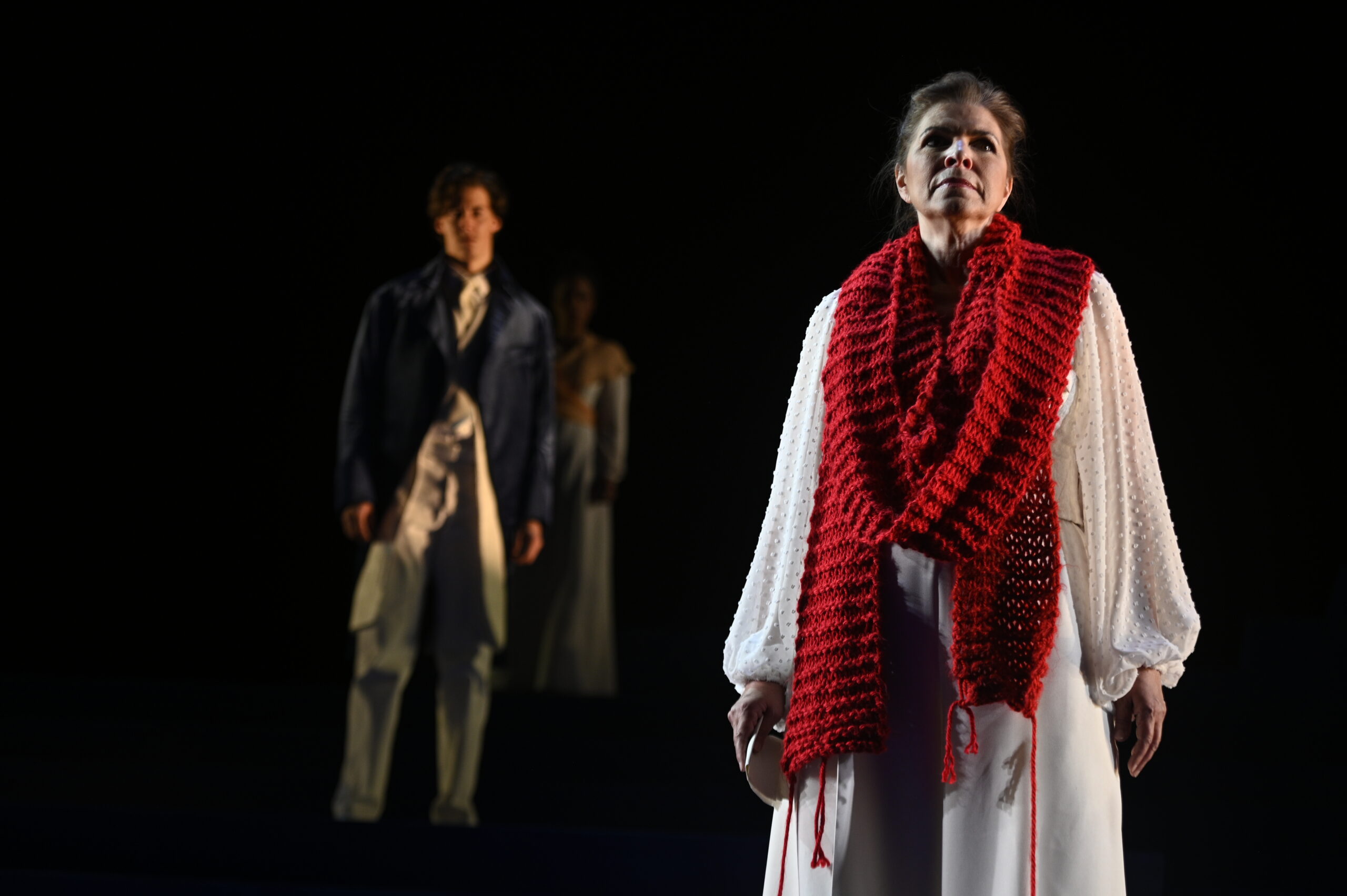From the beginning, we, as the audience, understand that Brendan Pelsue’s adaptation of A Tale of Two Cities won’t be a straightforward dramatization of Charles Dickens’ original text. He has employed numerous metatheatrical elements meant to heighten our awareness of the constructed nature of historical storytelling. This awareness runs throughout the world premiere production, currently on the Coca-Cola stage at Alliance Theatre through March 17.
Set during the events of the French Revolution, Dickens’ novel serves as an indictment of the upper class as well as a warning against mob mentality, and Pelsue’s adaptation channels both themes fairly well. At times, the script ruthlessly satirizes the aristocracy’s frivolity and self-centeredness. At others, the tone is much darker, tapping into the rage and bitterness of those who live their lives under the boots of the wealthy. It’s in these moments that the story comes alive, with Pelsue’s words and Leora Morris’s keen direction drawing out the humanity of Dickens’ writing in a way that feels timely.
We are greeted by narrators Stephen Ruffin and Tess Malis Kincaid, who introduce us to the actors and story. (Both play other roles in addition to narrating; the whole cast plays more than one.) Generally, I am a fan of this kind of postmodern approach — as Ruffin’s narrator reminds us, history is always happening, always was happening, and is always about to happen. However, it could be argued that A Tale of Two Cities overplays the hand. There are times, too, when the narration from the original text becomes too cumbersome. The opening scene where Charles is being put on trial is an attention trap — parts of it are compelling, but as it goes on, you can feel the script begin to buckle under the weight of its exposition.

Throughout the play, Kincaid’s narrator prompts the audience to make various exclamations in reaction to the play’s events (“Shock from the crowd, please!” is one example). While this is a fun and interactive tool, it’s easy to overuse. The efficacy depends on the energy level of the audience, and the prescriptiveness of being told what emotion to express occasionally creates unease when the instructions don’t match how one is actually feeling. I would not necessarily count this a flaw, however, as it amplifies the story’s themes of individual vs. group thought. After all, a little discomfort in the theater is not always negative.
These techniques would not work as well without Kincaid’s authoritative voice behind them. Her instructions carry a certain quality to draw the audience in. It’s not until Act II, however, that you realize this is not just a strong performance from Kincaid — it is her career best. The blend of empathy and ferocity with which she endows each character she plays leads to some of the show’s most volcanic moments. If you leave the Alliance without her name on your lips, I can only assume you were watching an entirely different play.
The other driving force is Tiffany Denise Hobbs, whose performance is quieter but nonetheless affecting. She radiates sincerity and composure as Lucy Manette but manages to turn on a dime to make an absolute meal out of her dual role as the cartoonishly evil Marquis St. Evrémonde.
Every cast member gets their moment in the spotlight. A few others particularly worth noting are Lee Osorio — with whom Hobbs has excellent chemistry — and Brad Raymond, whose rendition of King Louis XVI is the show’s comedic highlight.

Visually, A Tale of Two Cities is nothing to complain about. Every inch of this production looks gorgeous or is calculated to match the unique blend of grandeur and metatheatrical distancing that the script exhibits. Jiyoun Chang knocks it out of the park with the scenic and lighting design, using spotlights to create little pockets of isolation which are incredibly effective at evoking a setting.
Fabian Fidel Aguilar’s costumes are similarly eye-catching, particularly the more flamboyant pieces used to accentuate the play’s satirical moments. These comedic beats may feel somewhat jarring when juxtaposed against the seriousness of the rest of the script, but Aguilar highlights them well.
Though the script is a bit bulky, occasionally stumbling in attempts to streamline a dense novel, the moments that land do so with show-stopping intensity. The ambition behind Pelsue’s adaptation must be applauded; he clearly has a keen sense for what makes the story relevant for the modern era.
::
Luke Evans is an Atlanta-based writer, critic and dramaturg. He covers theater for ArtsATL and Broadway World Atlanta and has worked with theaters such as the Alliance, Actor’s Express, Out Front Theatre and Woodstock Arts. He’s a graduate of Oglethorpe University, where he earned his bachelor’s degree, and the University of Houston, where he earned his master’s.

